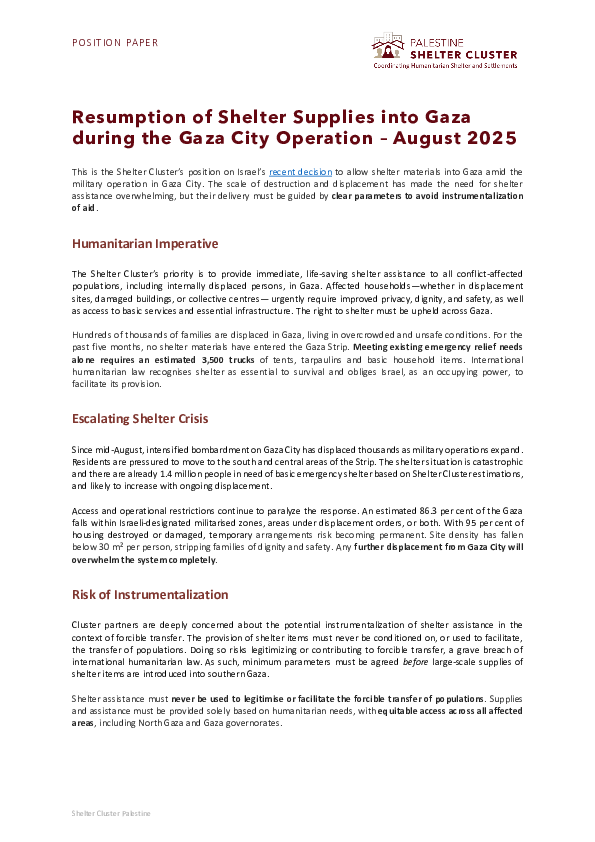Palestine
Resumption of Shelter Supplies into Gaza during the Gaza City Operation – August 2025
Resumption of Shelter Supplies into Gaza during the Gaza City Operation – August 2025
This is the Shelter Cluster’s position on Israel’s recent decision to allow shelter materials into Gaza amid the military operation in Gaza City. The scale of destruction and displacement has made the need for shelter assistance overwhelming, but their delivery must be guided by clear parameters to avoid instrumentalization of aid.
Humanitarian Imperative
The Shelter Cluster’s priority is to provide immediate, life-saving shelter assistance to all conflict-affected populations, including internally displaced persons, in Gaza. Affected households—whether in displacement sites, damaged buildings, or collective centres— urgently require improved privacy, dignity, and safety, as well as access to basic services and essential infrastructure. The right to shelter must be upheld across Gaza.
Hundreds of thousands of families are displaced in Gaza, living in overcrowded and unsafe conditions. For the past five months, no shelter materials have entered the Gaza Strip. Meeting existing emergency relief needs alone requires an estimated 3,500 trucks of tents, tarpaulins and basic household items. International humanitarian law recognises shelter as essential to survival and obliges Israel, as an occupying power, to facilitate its provision.
Escalating Shelter Crisis
Since mid-August, intensified bombardment on Gaza City has displaced thousands as military operations expand. Residents are pressured to move to the south and central areas of the Strip. The shelter situation is catastrophic and there are already 1.4 million people in need of basic emergency shelter based on Shelter Cluster estimations, and likely to increase with ongoing displacement.
Access and operational restrictions continue to paralyze the response. An estimated 86.3 per cent of the Gaza falls within Israeli-designated militarised zones, areas under displacement orders, or both. With 95 per cent of housing destroyed or damaged, temporary arrangements risk becoming permanent. Site density has fallen below 30 m² per person, stripping families of dignity and safety. Any further displacement from Gaza City will overwhelm the system completely.
Risk of Instrumentalization
Cluster partners are deeply concerned about the potential instrumentalization of shelter assistance in the context of forcible transfer. The provision of shelter items must never be conditioned on, or used to facilitate, the transfer of populations. Doing so risks legitimizing or contributing to forcible transfer, a grave breach of international humanitarian law. As such, minimum parameters must be agreed before large-scale supplies of shelter items are introduced into southern Gaza.
Shelter assistance must never be used to legitimise or facilitate the forcible transfer of populations. Supplies and assistance must be provided solely based on humanitarian needs, with equitable access across all affected areas, including North Gaza and Gaza governorates.
Providing shelter in restricted areas does not offer a pathway to recovery in Gaza—neither for housing, nor for longer-term solutions. Forcing additional people into already overcrowded sites only heightens risks, including poor health outcomes, fire hazards, and gender-based violence.
Principles for Shelter Assistance in Gaza
No one-size-fits-all solution: The Shelter Cluster has identified complementary options such as housing repairs, collective centre upgrades, emergency shelter kits, and community-led approaches. Tents alone are insufficient to meet Gaza’s needs.
Flexibility and dignity: Beyond diversity of options, families must be able to adapt and upgrade their shelter over time. Imposed, rigid solutions risk eroding dignity and undermining resilience.
Timing of supplies: Stocks must be strategically pre-positioned to ensure availability when major displacement occurs, as seen repeatedly in Gaza, to prevent supplies from being depleted during sudden surges in need.
Key Points at a Glance
-
Needs are overwhelming: more than 95 per cent of housing has been destroyed or damaged, with at least 3,500 trucks of materials needed to provide emergency shelter and basic rapid repairs.
-
The Shelter Cluster pipeline — covering all corridors and including both procured and in-process items — currently holds around 86,000 tents, over 1 million tarpaulins and sealing-off kits, and some 5 million non-food items. Ongoing restrictions on INGOs and UNRWA continue to block shelter deliveries, with critical materials denied entry even after approval. The Zikim crossing must remain open to ensure aid reaches northern Gaza, including during intensified military operations.
-
Aid must not be instrumentalised: shelter assistance cannot be used to legitimise or enable forcible transfer.
-
Shelter assistance must include a range of solutions: housing repairs, collective centre upgrades, emergency kits, and community-driven approaches. They must provide safe, dignified options beyond tents, enabling families to adapt shelter to their needs.
Shelter actors will operate under clear principles: assistance based solely on need, delivery across all areas, including northern Gaza, and solutions that remain temporary and transitional, linked to durable housing, land, and property solutions that uphold displaced families’ right to return to their homes in Gaza.

